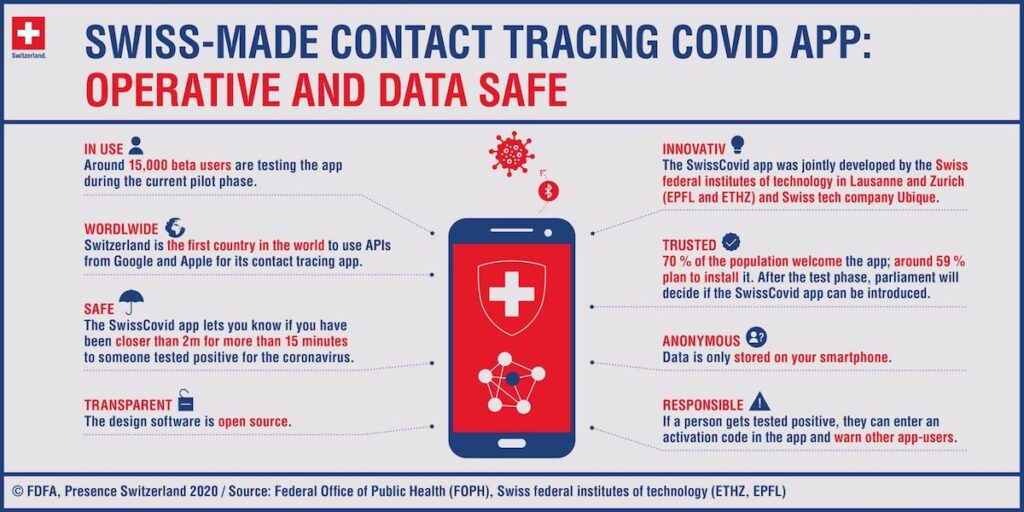In May, the Swiss Parliament decided that a legal framework must be put in place. The Federal Council submitted the Botschaft for the urgent federal law on the corona tracing app on 20 May. This week, the Swiss Parliament finally gave green light to officially make the app available for the general public. The app will be published by the Federal Office of Public Health (FOPH). According to a survey, 70 percent of the Swiss population welcomes its introduction.
This blog takes a closer look at the App and what we can expect from it, the current status of the worldwide release of digital contact tracing apps and the critical questions that are still open.
The new proximity tracing app has raised high hopes to get back to normal. The SwissCovid-App is designed to alert users who have been in contact with a person who has tested positive for the coronavirus. It notifies the user if he or she has been less than two meters away from an infected person for more than fifteen minutes.
As great the potential benefits of such an application are, it is crucial to be also aware of potential risks. It is crucial that the data collected for contact tracing may never be used for other purposes – or linked to other data to identify and possibly further profile individuals.
Regarding the SwissCovid-App, the technical aspects are fulfilled. The App fulfills the criteria of “privacy by design”, does not track the user’s location, only the proximity between users of the app based on Bluetooth. In a first blog about proximity tracing apps, I summarized the formal criteria that must be met for a trustworthy app: voluntary, transparency, privacy by design, decentralized storage and processing of data, temporary, necessary, proportionate and scientifically validated. However, to be effective, the app must be used by as many people as possible. Trust in the app is therefore essential.
Within a very short amount of time, a team of developers and researchers has developed a complex distributed app that meets the highest technical, security and data protection standards. The SwissCovid App is based on the Apple-Google API. This makes Switzerland the first country in the world to use the Google and Apple interface for proximity tracing. By joining forces, Apple and Google are setting the global standard – which in turn was decisively shaped by the Swiss researchers from ETHZ and EPFL. They were able to win over the two tech giants for the decentralized approach, which offers maximum data and privacy protection.

To this date, at least 48 contact-tracing apps are available globally. Australia, South Korea, France and Singapore, for instance, have already implemented contact tracing apps. Many other governments are testing or considering them. This public list gives a good overview of the various contact tracing apps and digital tracking measures in use around the world. The approaches differ considerably from country to country. There are roughly two camps: the centralized and decentralized approach
For instance, France and the UK currently use a central protocol. Under this system, data is entered into centralized computer systems operated by the government. In Switzerland, the protocol and storage of data is decentralized. This offers users more privacy and control over their information by keeping it on their phone. Many countries in Europe, for example Germany, opt for the decentralized approach based on the Swiss model, which is also promoted by Apple and Google.
South Korea’s contact-tracing approach uses video surveillance, credit card data and geolocation information. This extensive collection of data and intrusive surveillance is problematic from a data protection perspective.
With only a quarter of the population having downloaded the app, Singapore is now even going a step further. The government is working on a contact tracing method using a portable, wearable device that could be distributed to everyone in the country.
The parliamentary decision to create a legal framework for the app has allowed a broad public debate on the potential benefits and risks of digital contact tracing, and the clarification of open questions about the process. It underlines the dimension of voluntariness by prohibiting companies and others to force people to use the app. After a test phase, which involved around 15’000 people, the testing of the security, as well as functionality of the app, we will have soon an app available that meets key privacy and security issues from a technical point of view, while at the same time being introduced in a clear and legal framework that protects the rights and freedoms of citizens. In addition, the Federal Council should be able to stop the app when it is no longer necessary or when the app proves to be insufficiently effective. These points are of crucial importance and, in combination with transparency and communication along the process, have helped to create trust. Thus, the Swiss App could potentially serve as a global role model for responsible digital contact tracing. As part of a broader strategy (test, trace, isolate), digital contact tracing could make a significant contribution to the common good and be an act of solidarity
However, the real test to prove its effectiveness starts with its public release, expected at the end of June. It is an experiment. No one knows today how many people will actually use the app, what long-term impact this will have on our society and our use of new technologies. The debate and development process of the app is so far seen positive, yet its release should be followed critically. Bluetooth technology is not flawless either. It cannot be completely ruled out that so-called “false positives” – i.e. false reports of a possible infection – will occur more frequently than in classical contact tracing. Whether the SwissCovid-App will be a success story will be seen in the next days and weeks.






